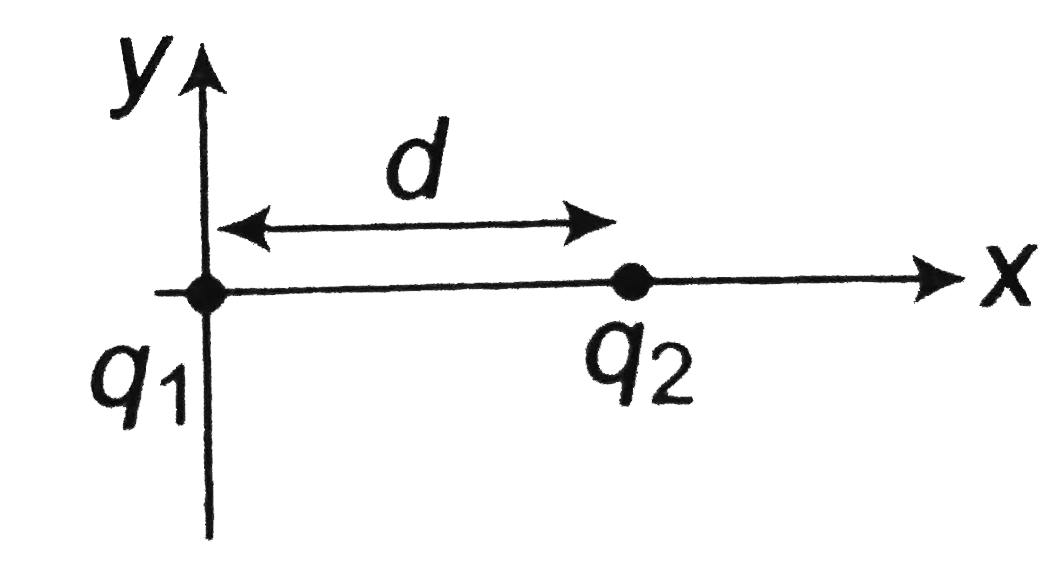Two point charges +8q and -2q are located at x=0 and x=L respectively. The location of a point on the x-axis from +8q at which the net electric field due to these two point charges is zero is
2L
L/4
8L
4L
The correct Answer is:A
To find the location on the x-axis where the net electric field due to the two point charges +8q and −2q is zero, we can follow these steps:
Step 1: Identify the positions of the charges
- The charge +8q is located at x=0.
- The charge −2q is located at x=L.
Step 2: Set up the equation for the electric field
- Let x be the distance from the charge +8q where the electric field is zero.
- The distance from the charge −2q to this point will then be (x−L).
Step 3: Write the expression for the electric fields
- The electric field E1 due to the charge +8q at a distance x is given by:
E1=k⋅8qx2
- The electric field E2 due to the charge −2q at a distance (x−L) is given by:
E2=k⋅2q(x−L)2
Step 4: Set the magnitudes of the electric fields equal
Since the net electric field is zero, we set the magnitudes of E1 and E2 equal to each other:
k⋅8qx2=k⋅2q(x−L)2
Step 5: Simplify the equation
We can cancel k and q from both sides (assuming q≠0):
8x2=2(x−L)2
Step 6: Cross-multiply to eliminate the fractions
Cross-multiplying gives:
8(x−L)2=2x2
Step 7: Expand and rearrange the equation
Expanding the left side:
8(x2−2xL+L2)=2x2
This simplifies to:
8x2−16xL+8L2=2x2
Rearranging gives:
6x2−16xL+8L2=0
Step 8: Solve the quadratic equation
Using the quadratic formula x=−b±√b2−4ac2a:
Here, a=6, b=−16L, and c=8L2:
x=16L±√(−16L)2−4⋅6⋅8L22⋅6
Calculating the discriminant:
x=16L±√256L2−192L212
x=16L±√64L212
x=16L±8L12
Step 9: Find the two possible values for x
Calculating the two possible values:
1. x=24L12=2L
2. x=8L12=2L3
Step 10: Determine the valid solution
Since the point must be to the left of −2q (which is at x=L), the valid solution is:
x=2L3
Final Answer
The location of the point on the x-axis from +8q at which the net electric field is zero is:
x=2L3
- The charge +8q is located at x=0.
- The charge −2q is located at x=L.
- Let x be the distance from the charge +8q where the electric field is zero.
- The distance from the charge −2q to this point will then be (x−L).
- The electric field E1 due to the charge +8q at a distance x is given by:
E1=k⋅8qx2
- The electric field E2 due to the charge −2q at a distance (x−L) is given by:
E2=k⋅2q(x−L)2
Since the net electric field is zero, we set the magnitudes of E1 and E2 equal to each other:
k⋅8qx2=k⋅2q(x−L)2
We can cancel k and q from both sides (assuming q≠0):
8x2=2(x−L)2
Cross-multiplying gives:
8(x−L)2=2x2
Expanding the left side:
8(x2−2xL+L2)=2x2
This simplifies to:
8x2−16xL+8L2=2x2
Rearranging gives:
6x2−16xL+8L2=0
Using the quadratic formula x=−b±√b2−4ac2a:
Here, a=6, b=−16L, and c=8L2:
x=16L±√(−16L)2−4⋅6⋅8L22⋅6
Calculating the discriminant:
x=16L±√256L2−192L212
x=16L±√64L212
x=16L±8L12
Calculating the two possible values:
1. x=24L12=2L
2. x=8L12=2L3
Since the point must be to the left of −2q (which is at x=L), the valid solution is:
x=2L3
The location of the point on the x-axis from +8q at which the net electric field is zero is:
x=2L3
Topper's Solved these Questions
- BOOK - AAKASH SERIESCHAPTER - ELECTRIC CHARGES AND FIELDSEXERCISE - Exercise-II56videos
ELECTRIC CHARGES AND FIELDS
- BOOK - AAKASH SERIESCHAPTER - DUAL NATURE OF RADIATION AND MATTEREXERCISE - PRACTICE EXERCISEX42videos
DUAL NATURE OF RADIATION AND MATTER
- BOOK - AAKASH SERIESCHAPTER - ELECTRIC FIELD AND POTENTIALEXERCISE - PROBLEMS (LEVEL-II)26videos
ELECTRIC FIELD AND POTENTIAL
Similar Questions
Two point charges +8q and −2q are located at x=0 and x=L respectively. The location of a point on the x axis at which the net electric field due to these two point charges is zero is
View Solutiontwo point charges + 16 q and -4q located at x=0 and x=L respectively. the location of a point on the x-axis from x=0, at which the net electric field due to these two charges is zero is
View SolutionTwo point charges Q and -Q/4 are separated by a distance x.
 View Solution
View SolutionTwo point charges +q and -q are held fixed at (−a,0) and (a,0) respectively of a x-y coordinate system then
View SolutionTwo point charge −q and +q/2 are situated at the origin and the point (a,0,0) respectively. The point along the X-axis where the electic field Vanishes is
View SolutionTwo point charges −q and +q are located at points (0,0−a) and (0,0,a) respectively. The electric potential at point (0,0,z)is (Z>a)
View SolutionTwo charges q1andq2 are placed at (0,0,d) and (0,0,-d) respectively. Find locus of points where the potential is zero.
View SolutionPoint charges +4q,−q and +4q are kept on the x-axis at points x=0,x=a and x=2a respectively, then
View SolutionTwo particles of charge q1 and q2 are separated by distance d as shown in figure. Chrage q1 is situarted at the origin. The net electirc field due to the particles is zero at x=d/4. With V=0 at infinity, the location of a point in terms of d on the x axis (other at infinfity) at which the elctrical potential due to the two particles is zero, is given by:
 View Solution
View SolutionTwo point charges (+Q) and (−2Q) are fixed on the X-axis at positions a and 2a from origin respectively. At what positions on the axis, the resultant electric field is zero
View Solution

